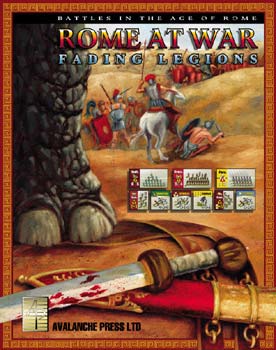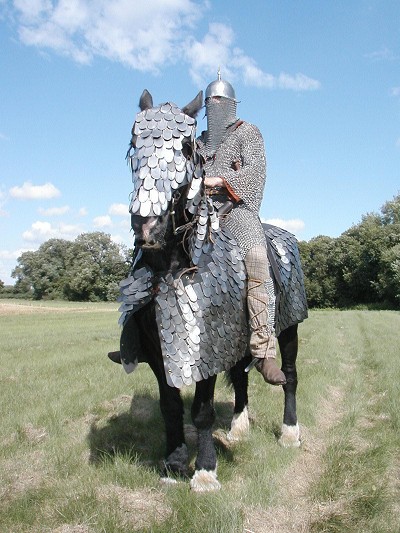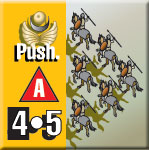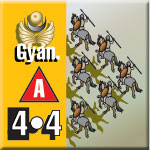Fading Legions:
The Sassanian Army, Part One
by Mike Bennighof, Ph.D.
March 2018
 Over a span of four centuries, Late Imperial Rome’s armies faced off along the Mesopotamian frontier with an equally professional force, the Royal Sassanian Army, known in Persian as the spah. Over a span of four centuries, Late Imperial Rome’s armies faced off along the Mesopotamian frontier with an equally professional force, the Royal Sassanian Army, known in Persian as the spah.
The Sassanid dynasty overthrew the Parthian Arsacid dynasty in 224 AD, and adopted many of their military practices. Chief among these was the reliance on heavy armored cavalry as a breakthrough weapon, their charges coordinated with a storm of arrows to disrupt enemy formations.
The Sassanids oppose the Romans in five of the eleven scenarios of Rome at War: Fading Legions, and are the centerpiece of the expansion book Rome at War: King of Kings. Let’s take a look at their army:
The Savaran
The heart of the Sassanid spah, the heavy armored cavalry, or savaran, underwent years of training from a fairly young age. Drawn exclusively from the nobility, the savaran numbered about 70,000 during the reign of Shapur II, the titular figure of our King of Kings book and the Persian ruler during the period in which Fading Legions takes place. Not all of those could be fielded at once, nor were they.
 A Persian mounted warrior, known in the West as a cataphract, wore mail armor completely covering both his (and in a few cases, her) body and that of his horse, and of course a helmet. During Shapur II’s reign, the savaran experimented with what historians call “super-heavy cavalry,” adding plate armor to the mail coat and extending it to better protect the rider’s legs. That made for a much slower charge but left the horsemen better able to fight Roman heavy infantry in the melee that followed. The added protection came at a severe cost: Roman staff officer and historian Ammianus Marcellinus records that they quickly became exhausted in prolonged close combat, thanks to the heavy weight of their armor. A Persian mounted warrior, known in the West as a cataphract, wore mail armor completely covering both his (and in a few cases, her) body and that of his horse, and of course a helmet. During Shapur II’s reign, the savaran experimented with what historians call “super-heavy cavalry,” adding plate armor to the mail coat and extending it to better protect the rider’s legs. That made for a much slower charge but left the horsemen better able to fight Roman heavy infantry in the melee that followed. The added protection came at a severe cost: Roman staff officer and historian Ammianus Marcellinus records that they quickly became exhausted in prolonged close combat, thanks to the heavy weight of their armor.
Lances provided the initial shock, and Persian nobles practiced relentlessly with them. The cavalry lance was a heavy, wooden weapon with a sword-like blade its point, known in Persian as an arsht. The savaran fought one-handed, with the lance couched under the dominant arm, against targets on foot and two-handed against enemy horsemen.
Since the Persians did not employ stirrups until the last decades of the empire (in the 7th century), their heavy cavalry rode in what’s known as a four-horned saddle to keep the rider from being thrown from his horse by the shock of his lance’s impact with its target. That appears to have worked well, but it could not keep the rider’s lance from breaking when striking an armored target or becoming mired in an enemy’s soft flesh.
Without a means to acquire a fresh lance during battle, the armored horseman next relied on his sword: a heavy weapon resembling the broadsword of later European armories, with a fairly narrow and simply guard. The horseman wore it attached to his belt on the side he preferred, with a swivel mechanism that allowed him to tilt the scabbard and draw the blade one-handed. Typically, he also carried at least one dagger strapped to his thigh.
While the savaran was long viewed by historians as dedicated exclusively to shock combat, more recent scholarship has accepted that they also carried bows and would be expected to add to the “arrow storm” that usually preceded a charge or covered a retreat. The super-heavy troopers apparently did not carry bows, it being all they could do to bear their armor.
The Imperial Guard
 Several elites existed within the savaran. Those from the highest level of the nobility, known as the asbaran, could afford better armor and horses and thereby displayed greater effectiveness in battle. But others earned their elite status by their deeds – a key concept of the empire’s state religion, Zoroastrianism. Several elites existed within the savaran. Those from the highest level of the nobility, known as the asbaran, could afford better armor and horses and thereby displayed greater effectiveness in battle. But others earned their elite status by their deeds – a key concept of the empire’s state religion, Zoroastrianism.
The best of the asbaran could look to inclusion in the pushtighban, the division (known as a gund) responsible for the personal safety of the king of kings. Only the highest nobles could enter, having proven battlefield valor, and they trained rigorously once enrolled.
The bravest savaran troopers, whatever their degree of nobility, could be appointed to the javidan, the Immortals. Modeled on the ancient Achaemenid dynasty’s famed elite, they were issued arms and armor (rather than having to supply it from their own resources) and fought with suicidal determination. Like the pushtighban they trained relentlessly during peacetime, and the two divisions usually fought alongside one another.
The most determined warriors – apparently from all social classes, including commoners, ethnic minorities and even foreigners – could volunteer for the jyanavspar, “those who court death.” Trained and equipped like the savaran, they would be placed in the very front of a mass lance attack where their disregard for their own lives could have maximum impact.
Allied Heavy Cavalry
The Kingdom of Armenia, ruled by an Arsacid offshoot of the Parthian dynasty, often provided heavy armored cavalry known as naxarars. Armed and trained in the same manner as the savaran, the naxarars additionally trained to fight on foot and took great pride in their swordsmanship. During Julian’s campaign in 363 the Armenians initially marched against Persia as Roman allies, but Julian’s insistence on adding pagan idols to Christian places of worship caused them to leave the alliance before they met the Persians in battle.
Persian Chivalry
 The individual savaran warrior fought not so much for his sovereign, the king of kings, as for the abstract ideals of frahang – the ancient Persian traditions of learning and culture. Persians considered that Romans could possess a frahang of their own, but Central Asian nomads and Arabs did not. The king of kings stood as the prime defender of frahang against barbarism, but each individual warrior was expected to display his honar, or battlefield bravery, in defense of his ideals. Honar had five pillars: bravery in close combat, skill with weapons, physical strength, enthusiasm for battle, and a willingness to die rather than lay down these ideals. The individual savaran warrior fought not so much for his sovereign, the king of kings, as for the abstract ideals of frahang – the ancient Persian traditions of learning and culture. Persians considered that Romans could possess a frahang of their own, but Central Asian nomads and Arabs did not. The king of kings stood as the prime defender of frahang against barbarism, but each individual warrior was expected to display his honar, or battlefield bravery, in defense of his ideals. Honar had five pillars: bravery in close combat, skill with weapons, physical strength, enthusiasm for battle, and a willingness to die rather than lay down these ideals.
To aid them in this endeavor, Zoroastrian priests known as mobads studied the stars to discern the most propitious moment for battle, and exhorted Ahura-Mazda to channel the five elements of honar into the Persian warriors through his son, Mithra. Before battle, the priests led prayers and warriors lifted their swords to Mithra; during the fighting the priests recorded the deeds of the valiant so they could be honored in the afterlife if killed or with earthly rewards if they survived. As the savaran prepared to charge, the priests sprinkled men and horses with holy water and loosed a sacred arrow in the direction of the enemy.
Calumny and Treason
The king of kings, even one as successful and venerated as Shapur II the Great, required a large imperial guard establishment to secure his reign. The savaran drew its troopers from the great noble houses of Sassanid Persia, which included ethnically Parthian families in some cases assimilated into the new order without a great deal of enthusiasm. Rivalry between Parthian and Persian nobles continued down to the very end of the empire, when in the face of Islamic Arab invasion the Parthian houses would be accused of withholding their support when most needed.
During the Roman Emperor Julian’s campaign against Shapur II in 363, Shapur’s brother Hormuzd rode against his countrymen along with a number – just how many is unclear – of savaran who followed him into exile and fought on the side of the Romans.
While Persian troopers fought with fanatic bravery, they expected the same of their sovereign. A king of kings who feared to risk his life in battle could not expect the loyalty of his men, and Shapur II fought in the front lines more than once to assure his troops of his own devotion to duty.
Design Notes
Fading Legions probably under-values the savaran; the pushtighban has a morale of 5 and the units labeled as jyanavspar (spelled Gyan here) one of 4. That latter designation is probably meant to indicate the “regular” savaran rather than “those who court death.” By comparison, morale of the best Roman legions is 6, and most receive a 5. Fading Legions also mis-labels some savaran units as Lakhmids, an Arab confederation that provided light cavalry in the 363 campaign; this has no actual effect on play.
King of Kings redresses that somewhat, introducing the jyanavspar with a special rule giving them extra benefits in combat but making them the first ones eliminated (thanks to that death-courting thing), and separating the Immortals from the pushtighban.
Next time, we’ll look at Persian infantry.
Put the savaran at your command! Order Fading Legions right now!
Mike Bennighof is president of Avalanche Press and holds a doctorate in history from Emory University. A Fulbright Scholar and award-winning journalist, he has published over 100 books, games and articles on historical subjects.
He lives in Birmingham, Alabama with his wife, three children and his dog, Leopold. Leopold reveres fahrang.
|
